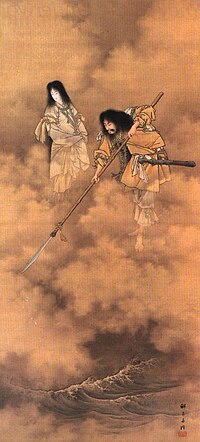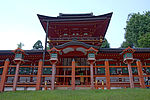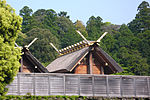Secular Shrine Theory or Jinja hishūkyōron (神社非宗教論) was a religious policy and political theory that arose in Japan during the 19th and early 20th centuries...
33 KB (4,355 words) - 18:00, 26 August 2024
State Shinto (section Yasukuni Shrine)
honoring the war dead;: 91 this is known as Secular Shrine Theory. The state also integrated local shrines into political functions, occasionally spurring...
46 KB (5,134 words) - 10:06, 5 October 2024
Miko (redirect from Shrine maiden)
functions in their service to shrines. As time passed, they left the shrines and began working independently in secular society. In addition to a medium...
21 KB (2,345 words) - 22:51, 26 September 2024
for the purification rituals often performed at Shinto shrines in Japanese religion, where shrine-goers wash themselves with water before entering the sacred...
14 KB (1,541 words) - 02:26, 12 October 2024
into them. In the United States, misogi was performed at the Tsubaki Grand Shrine of America at the Konryu Myojin no Taki waterfall each morning in the years...
6 KB (644 words) - 00:40, 23 September 2024
Shinto kami. There are many shrines dedicated to the goddess including Chiyo shrine, Tsubaki America Shrine and Tsubaki Grand Shrine. In some, she is worshiped...
12 KB (1,351 words) - 11:31, 3 September 2024
centuries, becoming more of a secular folk entertainment and less of a formal religious ritual. The sacred dance of the Sada shrine has been inscribed on the...
16 KB (1,804 words) - 20:22, 2 October 2024
emperor. Enshrined at Kashihara Shrine. Emperor Meiji (明治天皇), and Empress Shōken (昭憲皇太后). Enshrined at Meiji Shrine. Oda Nobunaga (織田信長) enshrined at...
30 KB (3,251 words) - 15:28, 6 October 2024
(saijin) worshipped at Hawaiian shrines (...) Ramella, Sueann (2013-10-08). "What's So Special About This Shinto Shrine? The Priest Isn't Japanese, But...
6 KB (160 words) - 16:29, 14 September 2024
Betsugu Tsukiyomi-no-miya Sanctuary of Kotaijingu (Naiku) at Ise city A shrine to Tsukuyomi-no-Mikoto at Matsunoo-taisha in Kyoto List of lunar deities...
5 KB (560 words) - 00:25, 2 September 2024
"employee/worker of kami"), is a person responsible for the maintenance of a Shinto shrine (神社, jinja) as well as for leading worship of a given kami. The characters...
6 KB (530 words) - 21:28, 11 May 2024
A Shinto shrine (神社, jinja, archaic: shinsha, meaning: "kami shrine") is a structure whose main purpose is to house ("enshrine") one or more kami, the...
82 KB (9,505 words) - 01:13, 10 October 2024
the shrines dedicated to their worship. Many festivals involve believers, who are usually intoxicated, parading, sometimes running, toward the shrine while...
33 KB (4,272 words) - 15:05, 2 October 2024
separated from Shinto shrines in 1940, becoming independent.[citation needed] Seicho-no-Ie List of Shinto shrines Secular Shrine Theory Shinto sects and schools...
8 KB (938 words) - 13:13, 10 June 2024
Grand Shrine, "the holiest of all Shinto shrines", wooden charms named ō-harai, another name for harae or harai, are hung all over the shrine. In all...
7 KB (891 words) - 14:57, 15 September 2024
to Shinto shrines. For lists of Shinto shrines, see: List of Shinto shrines in Japan List of Shinto shrines in Kyoto List of Shinto shrines outside Japan...
476 bytes (53 words) - 00:32, 2 September 2024
with a grudge. Examples of the former include toya (head priests), miko (shrine maidens), and masquerading deities in the rituals of the miya-za. Throughout...
7 KB (793 words) - 06:32, 15 August 2024
Kasuga-taisha (redirect from Kasuga shrine)
Kasuga-taisha (春日大社) is a Shinto shrine in Nara, Nara Prefecture, Japan. It is the shrine of the Fujiwara family, established in 768 CE and rebuilt several...
17 KB (1,816 words) - 02:16, 28 June 2024
Shinbutsu-shūgō (section Honji suijaku theory)
the prohibition of Buddhism at the Ise and Kamo Shrines allowed them to freely develop their theories about the nature of kami. During the Shinbutsu bunri...
24 KB (2,855 words) - 20:23, 10 October 2024
Ise Shrine is a shrine complex composed of many Shinto shrines centered on two main shrines, Naikū [ja] (内宮) and Gekū [ja] (外宮). The Inner Shrine, Naikū...
58 KB (4,870 words) - 22:52, 27 September 2024
Tomoe (section Theories of its origin)
popularity among samurai, since Ōjin was apotheosized as a god in Hachiman shrines. In the Nihongi account, when Ōjin was born, inspection of his body revealed...
22 KB (2,558 words) - 13:56, 7 September 2024
State Shinto was separated from its religious aspects based on the Secular Shrine Theory. In particular, Tenrikyo grew rapidly from the mid-Meiji period...
142 KB (20,195 words) - 17:44, 25 September 2024
'Male-who-invites' and 'Female-who-invites'. Shiratori Kurakichi proposed an alternative theory which instead sees the root iza- (or rather isa-) to be derived from isao...
16 KB (1,815 words) - 16:12, 20 September 2024
Shinto in Korea (section The Shinto shrine issue)
practitioners of Shinto. The earliest Shinto shrine in Korea is believed to be Kotohira shrine (金刀比羅神社), later Ryūtōsan Shrine (龍頭山神社), built in 1678, built by workers...
14 KB (1,688 words) - 00:31, 13 August 2024
Shrine Hokkaidō Jingu Hokkaidō Tōshō-gū Hokumon Shrine Itsukushima Shrine Iwamizawa Shrine Kamikawa Shrine Nishino Shrine Obihiro Shrine Ōta Shrine Sapporo...
25 KB (1,743 words) - 16:37, 6 September 2024
Susanoo-no-Mikoto (section Hikawa Shrine network)
the Yasaka shrine network Tsushima Shrine (津島神社) in Tsushima, Aichi Prefecture – Head shrine of the Tsushima shrine network Hiromine Shrine (広峰神社) in Himeji...
88 KB (10,695 words) - 17:57, 20 September 2024
Shinto Shrines (神社本庁, Jinja Honchō) is a religious administrative organisation that oversees about 80,000 Shinto shrines in Japan. These shrines take the...
9 KB (1,067 words) - 00:39, 22 September 2024
Divine command theory (also known as theological voluntarism) is a meta-ethical theory which proposes that an action's status as morally good is equivalent...
32 KB (4,222 words) - 01:45, 2 April 2024
List of Shinto shrines in Kyoto includes many Shinto shrines; but this list encompasses only some of the 400 Shinto shrines with scattered locations throughout...
4 KB (310 words) - 00:32, 2 September 2024
aims to promote patriotic education, support official visits to Yasukuni Shrine and promote a nationalist interpretation of State Shinto. It also denies...
35 KB (3,311 words) - 15:54, 8 October 2024

















